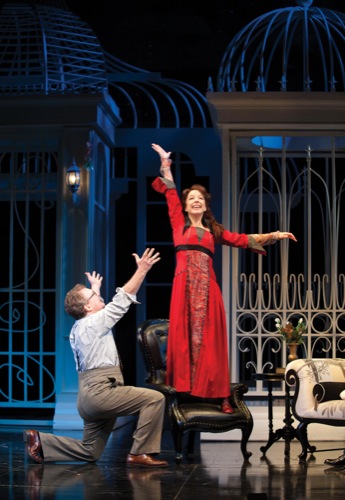
“My Fair Lady” by Emily Cooper, courtesy Shaw Festival
You won’t find a bevy of vendor booths selling everything from corn dogs and cotton candy to helium-filled balloons when you attend the Glimmerglass Festival near Cooperstown, N.Y. There are no face painters or stilt walkers at the Shaw Festival in
Niagara-on-the-Lake, Ontario; no rock
bands on outdoor stages or carnival rides at
the Utah Shakespeare Festival in Cedar City, Utah.
What these theater festivals and others like them have are high-quality productions of dramas, comedies, musicals, Shakespeare plays and opera. Although they are billed as festivals and generally have concentrated runs of just a few months, their focus is on the productions; the festivities surrounding them are more subdued.
But that doesn’t mean groups can’t have an enjoyable afternoon and evening with ancillary events connected to the festivals, followed by a well-produced play.
Glimmerglass Festival
Cooperstown, N.Y.
The Glimmerglass Festival presents three operas and a classic musical each July and August in a barn-style theater specially designed for it on the shores of scenic Lake Otsego, which James Fenimore Cooper called Glimmerglass in his 19th-century novel “The Deerslayer.”
The plays are presented in rotation: “You could see all four in a span of three days,” said Brittany Lesavoy, director of public relations for the festival.
Lesavoy said the architect designed the theater to take advantage of the surrounding rural landscape. “In order to bring the outdoors into the theater, it has giant walls that slide open,” she said. “They are open when the audience comes in and again at intermission.”
All of the 914 seats are within 70 feet of the stage, and the sound is unamplified.
Internationally recognized Francesca Zambello implemented several additional events after becoming the artistic and general director of the Glimmerglass Festival in 2010.
“At the pavilion next to the theater, there are concerts featuring young artists and apprentices,” said Lesavoy. “There also is a lecture series and free previews before every main stage performance by a member of the cast, who talks to the audience about what they are going to see.
“And you can picnic all around our 26 acres. You can bring your own, we have concessions stands, or you can order a gourmet dinner in advance.”
The Fenimore Art Museum in nearby Cooperstown is offering group packages with the festival that feature guided tours of the museum, catered picnics on the festival grounds and behind-the-scenes tours in addition to the performances.
— www.glimmerglass.org —
Shaw Festival
Niagara-on-the-Lake, Ontario, Canada
What began in 1962 as an eight-performance summer salute to George Bernard Shaw has grown into an internationally renowned six-month festival with nearly 800 performances of 10 to 12 plays in four theaters.
Although the festival’s original purpose was to produce works of Shaw and his contemporaries, it has expanded to include plays written after Shaw’s 1950 death.
Local lawyer and playwright Brian Doherty started the festival in the Assembly Room of Niagara-on-the-Lake’s historic courthouse. The 327-seat thrust configuration Court House Theatre is still used by the festival, which rebuilds the theater space each year.
The Shaw’s flagship theater is the 856-seat Festival Theatre, officially opened in 1973 by Queen Elizabeth II. The proscenium-arch theater is the site of the festival’s large-scale productions.
The festival’s other two venues are the 328-seat Royal George Theatre, a restored 1915 vaudeville house with elaborate Edwardian gilt moldings, red walls and golden lions, and the flexible-seating Studio Theatre, which doubles as a rehearsal hall, in a new production center attached to the Festival Theatre.
The Shaw Festival is set in the scenic wine country of southern Ontario; there, groups can visit wineries, orchards, museums and the charming and historic town of Niagara-on-the-Lake before or after attending a play.
— www.shawfest.com —
Utah Shakespeare Festival
Cedar City, Utah
Nikki Allen, media and public relations manager for the Tony Award-winning Utah Shakespeare Festival, noted that although “Shakespeare is our cornerstone,” the festival, which runs June 21 to Oct. 20 this year, presents a wide variety of plays.
“It is not just Shakespeare,” she said. “This year we have the epic musical ‘Les Miserables’ and ‘To Kill a Mockingbird,’ which is marking its 50th anniversary. We have six plays going on simultaneously; it changes every night.”
However, Shakespeare is still the main spotlight. “Because of his language and universal themes, we find his works are timeless,” she said.
The festival’s two main theaters are the Adams Shakespeare Theatre, an outdoor venue modeled after 16th-century Tudor stages similar to those where Shakespeare’s plays were originally presented, and the contemporary indoor Randall L. Jones Theatre.
Allen said plays produced in the Adams are kept authentic to Shakespeare’s originals. “We don’t put Hamlet on the moon,” she said. “It’s Shakespeare under the stars; it’s very intimate.
“The Randall L. Jones has a more modern, contemporary feel, and we do experiment more in there.”
In February, the festival announced plans for a new $26.5 million, 900-seat Shakespeare theater on the campus of Southern Utah University to replace the 35-year-old Adams. Slated to be completed in early 2015, the new theater will have a retractable roof and more audience amenities.
“It’s not just about coming to see plays at the festival,” said Allen. “It is the whole experience. There are backstage tours, seminars, costume discussions. We try to make it an all-day event.”
— www.bard.org —











